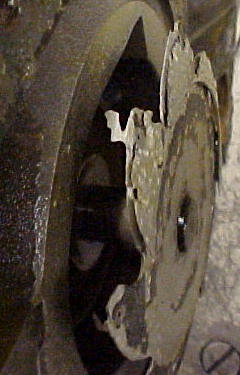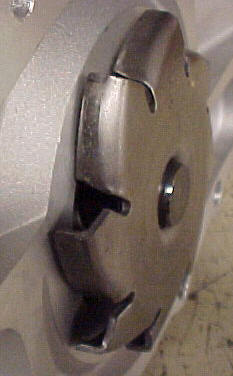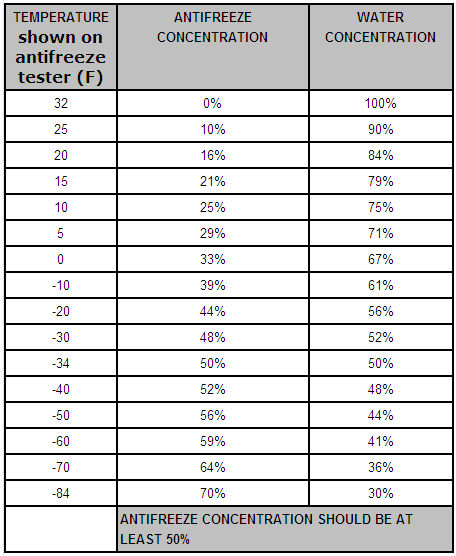Engine Coolant
Coolant Leaks and Coolant Types
It is very important that antifreeze or engine coolant is changed every 2 -3 years (4 - 5 years for vehicles with long life coolants) to replenish the additives that protect the cooling system from rust, corrosion, pitting, electrolysis, gelling and foaming. Your automobile cooling system should have a concentration of 50% to 70% antifreeze to water at all times for good protection.
Vehicles using Extended Life coolant should be changed in about 50,000 miles or 4 years to prevent system damage and radiators and heater cores becoming restricted. It is not unusual to find plugged heater cores or radiators on vehicles that have gone too long without coolant being changed. A restriced heater core will cause no or poor heat from the heater and restricted radiators can cause overheating, especially in the summer.
Is Antifreeze Really Important?
Yes, but not just because of the danger of freezing though. In the early days of Automobiles when engines were very simple and made entirely of steel, water worked OK to cool the engine as long as it was drained regularly (sometimes nightly in the winter) to prevent rust and freezing.
The first antifreeze solution consisted of alcohol, which prevented freezing but was inefficient and didn't prevent rust or corrosion.
More stable and efficient solutions to prevent the coolant from freezing in the engine were soon created which were the forerunners of what we use today.
The modern antifreeze, however, does much more. It provides year-round protection of the cooling system: With proper additives it prevents freeze up in winter and boil over in summer (especially in cars with air conditioning). It provides protection from rust and corrosion and does not harm rubber hoses and plastics.
Antifreeze should not corrode metal parts, attack rubber, become viscous at low temperatures, or evaporate readily at the ordinary engine operating temperature. It should be a good conductor of heat, and a poor conductor of electricity (which causes electrolysis).
The performance requirements of antifreeze became more severe starting in the 1980's. The down sizing of vehicles to improve fuel economy meant extensive use of light materials such as aluminum and plastics for the construction of engine and cooling system parts.
The amount of antifreeze used was also reduced to further reduce weight, subjecting the antifreeze to high rates of flow, high temperatures and significant metal-to-coolant heat fluxes. Today's smaller, efficient and powerful engines dissipate more heat, requiring that the antifreeze keep the heat exchange surfaces in clean condition. In addition, corrosion, which in itself is of concern, can also result in heavy corrosion deposits that slows heat transfer.
Unfortunately the additives in our antifreeze breakdown over time and while it may still prevent freezing it will fail to protect the hoses and engine components from deteriorating.
What is Electrolysis?
As the additives in your coolant that keep it neutralized become depleted over time, the coolant can actually develop an electric charge from passing over dissimilar metals.
You can even measure this voltage with a voltmeter. This small electric current removes metal from engine surfaces leaving large pits or holes and can eventually eat entirely through a component. It can also weld bolts and fittings to the engine and components.
This can be caused by coolant that is too old or antifreeze mixtures that are not close to 50%.
A Digital Multi-meter can sometimes be used to test for this.
- Attach the DMM ground probe to the negative battery post.
- Insert the tip of the positive probe into the coolant and observe the reading.
OK - less than .10 volts.
Bad - anything above .20 volts.
There are also other properties of coolant that degrade and cause problems long before electrolysis is present. Old coolant that has had its additives depleted causes radiator and heater core tubes to start get restricted from corrosion and rust and scale buildup which won't show with a voltmeter test.


Picture on the left is from a badly eaten away water pump impeller because of very old coolant.
The picture on the right is a new pump for the same vehicle.
The old pump was no longer able to pump water and the electrolysis had also taken out the timing cover gasket.
Electrolysis destroyed this head gasket. It started leaking from a coolant
passage to the outside of the engine after the material was eaten away.
Antifreeze Concentration Chart

Good reasons to bring your Car, SUV or Light Truck to Wayne's Garage
- We warranty all our work for 24 month/36,000 miles
- We have courtesy vehicle to get you home or work.
- We hand wash and vacuum your car
- Our friendly staff will always treat you with dignity and respect
- Most repairs are completed in one day
- We can perform all maintenance necessary to keep your new car warranty in effect. You are not obligated to go back to the dealer.
- Our Technicians are ASE certified.
- Wayne's Garage has over 100 years of experience to maintain and repair your automobile.
Call for an Appointment:
541-746-7142


